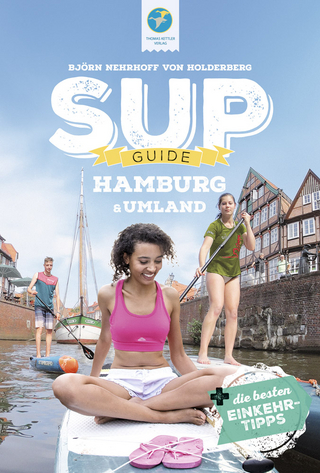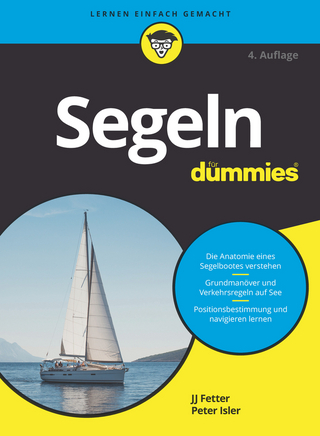
The Mindful Art of Wild Swimming
The Ivy Press (Verlag)
978-1-78240-757-7 (ISBN)
- Keine Verlagsinformationen verfügbar
- Artikel merken
The Mindful Art of Wild Swimming explores how swimming in rivers, lakes, and seas is the very epitome of conscious living. Zen-seeker Tessa Wardley reconnects the physical and spiritual cycles of life to the changing seasons and flow of wild waters worldwide and leads the reader on to a mindful journey through the natural world. With expert insight and personal anecdote, she shares a sparkling clarity on why our relationship with open water is so fundamental to pure wellbeing, and reveals how wild swimming can be the ultimate Zen meditation.
Tessa Wardley is a river-lover and mini-adventurer who has worked and played in waters worldwide from New Zealand to the Arctic Circle. She is also a renowned global environmental policy consultant, and before that, the policy advisor to the UK's Environment Agency. She has written The River Book, The Woodland Book, and The Countryside books, inspirational titles encouraging readers to have adventures outdoors. She is also author of The Mindful Art of Wild Swimming and Mindful Thoughts for Runners. Tessa Wardley is a river-lover and mini-adventurer who has worked and played in waters worldwide from New Zealand to the Arctic Circle. She is a former global environmental consultant and water manager for the UK's Environment Agency, and mother of four daughters. Tessa is the author of The River, Woodland, and Countryside (Bloomsbury) and practices mindfulness in her everyday life.
Prelims pp1-7
Introduction: The Essence of Man pp8-15
"Live by a clean river and you have everything you need, even a fish for supper." Rupert Wright
Man in his natural element-how and why natural waters have been so important in the evolution of man. Civilizations settling by rivers, exploration of new lands over the seas. Why immerse yourself-why we swim and what we gain from it. What is mindfulness and how does swimming in open waters contrast with swimming in a pool?
Chapter one: Taking the Plunge pp16-27
How to get started. Planning to swim outdoors. Techniques for open-water swimming. Birth (the river at its source), sacred springs, birth rituals in many religions. Sacred springs-Australia and the aboriginal beliefs around water pools.
Mindfulness exercise: The importance of finding your rhythm-breathing.
Chapter two: The Solo Swim pp28-41
"There is practically no difference between flying in the water and flying in the air. ... It was like the dreams people have." TH White
Branching out on your own, finding your feet, youth, independence. Release your inner fish-like flying. Cultural releases of sending people on their way, recognizing them as a separate entity-baptism, immersion. Launching off from the beach, striking out for distance goals. Swimming in lakes (Coniston/Sweden), swimming out to offshore islands (Scillies).
Mindfulness exercise: Ripple-free swimming.
Chapter three: Swimming with Friends pp42-55
"Small, shiny children were playing like otters on the riverbanks." Jay Griffiths
Swimming in Pyrenean rivers, exploring Sardinian coast. Youthful rivers, lots of energy and noise, carrying large stones and small boulders, change and development. Gamboling and having fun like otters playing, sliding down rock shutes, exploring water holes and small waterfalls-lots of diversity and new experiences. Playing in the surf, exploring rocky pools, caves and rock arches along the shoreline. Water as calming agent and leveler of people.
Mindfulness exercises: Enjoy the moment.
Chapter four: Swimming Adventures pp56-73
"I wanted the river. Its wildness. I wanted to strip naked and let the water lick my skin." Sue Monk Kidd
Midlife, summer swimming adventures all over the world. Fast-flowing large waters, different layers of needs and different layers of water-feel the stratification of the water in the bands of warm and cold water. Dense vegetation of the riverbank and the diversity of the wildlife. What do we get emotionally from the different kinds of swimming? Enrichment, calm, escapism, cleansing, humility in the face of nature's power and beauty. Skinny-dipping in Australia. Waterfalls in Nepal/Corsica. Night swimming in Kenya. The long swim down the Thames. Swimming like Tarzan in the Amazon. Island hopping in Croatia. Exploring hidden bays in Wales.
Mindfulness exercise: Feel the burn.
Chapter five: Reaping the Rewards pp74-87
"Once in the water Iris cheers up a bit. It is almost too warm, hardly refreshing. But its old brown slow-flowing deliciousness remains, and we smile happily at each other as we paddle quietly to and fro." John Bailey
Swimming in lowland rivers (Waveney in Norfolk), still inland seas (the Mediterranean). The benefits of swimming-physical, emotional, spiritual. The science and the research. The role of natural waters culturally and why we return to the water throughout the cycle of our lives for health, healing, and spiritual renewal. The cyclical nature of the seasons, our lives, and the cycle of water.
Mindfulness exercise : Go with the flow-enjoying being part of the water cycle.
Chapter six: Reflections from The Riverbank pp88-97
"Find beauty; be still." W H Murray
Much can be gained from observing water and its environment. Sitting by the river in the Pyrenees, sitting on the beach/cliffs in Tasmania-you don't have to get in the water if you are not in the mood. Watching the reflections and the wildlife and listening to the sounds.
Mindfulness exercise: Listen to the soundscape.
Chapter seven: Words of Wisdom pp98-113
As with old age in man, the ancient river carries much with it. Every rock that the river has passed over and industrial waste stream has left its mark. Go and visit the last miles of a river and see the richness that they divest-salt marshes, mangrove swamps, and deltas the world over-vast areas of enriched vegetation feeding shoals of breeding fish and flocks of wading birds. Swimming in meanders to exploring the mangroves of Madagascar.
Mindfulness exercise: Just be.
Chapter eight: The Ungovernable Element p114-137
"Not hammer-strokes, but dance of the water, sings the pebbles into perfection." Rabindranath Tagore
The duality of water-benign and soothing, wild and powerful. River, lakes, and seas take on many personalities and are represented by many characters in cultures throughout the world. Natural waters are used in birth rituals and in death ritual-currently and historically. We must remember that we are part of nature, not distinct from it. Swimming in natural waters helps us to realize this and to achieve the goal of being at one with our world.
Endmatter: Glossary, references, index & acknowledgments pp138-144
| Erscheint lt. Verlag | 3.3.2020 |
|---|---|
| Reihe/Serie | Mindfulness |
| Verlagsort | Lewes |
| Sprache | englisch |
| Maße | 130 x 200 mm |
| Themenwelt | Sachbuch/Ratgeber ► Sport ► Segeln / Tauchen / Wassersport |
| Geisteswissenschaften ► Religion / Theologie ► Buddhismus | |
| ISBN-10 | 1-78240-757-X / 178240757X |
| ISBN-13 | 978-1-78240-757-7 / 9781782407577 |
| Zustand | Neuware |
| Haben Sie eine Frage zum Produkt? |
aus dem Bereich


